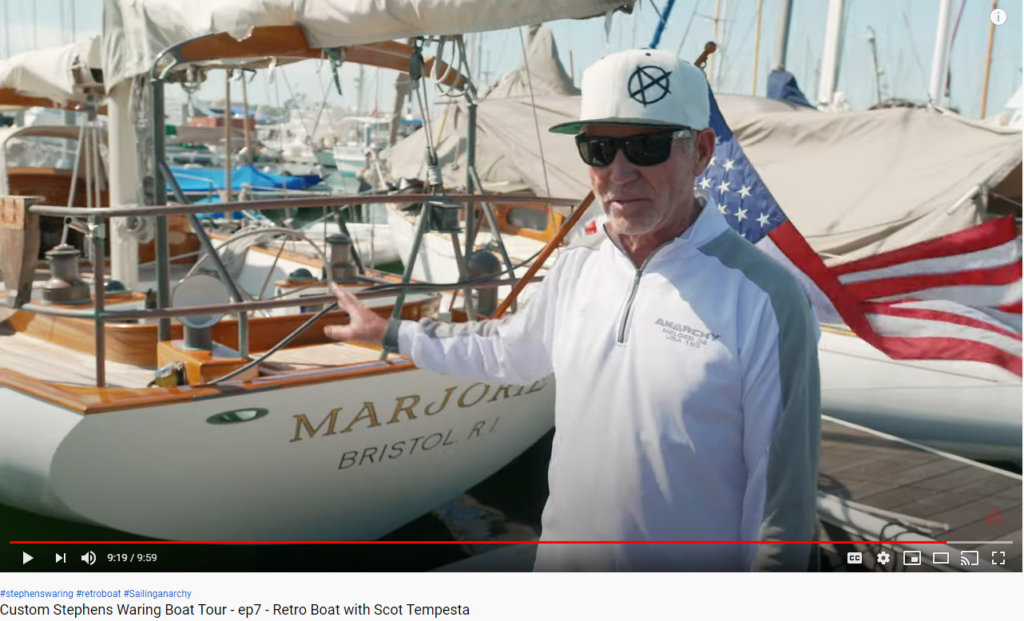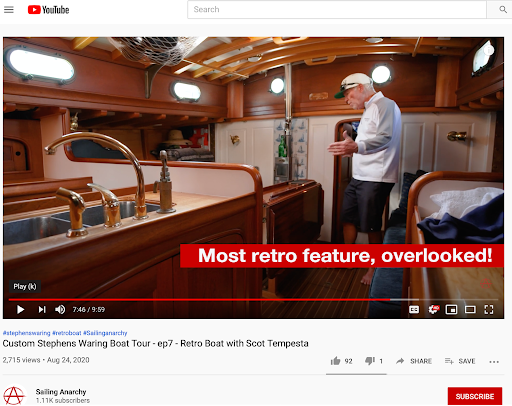If you’re a fan of yachts and yachting, there’s a good chance that like us, you’re a fan of Scot Tempesta’s great work with the Sailing Anarchy website. So when we heard that Scot was featuring a walk-through of Marjorie on his YouTube page (subscribe here) we were thrilled.

Like many of our designs, Marjorie was custom-tailored to meet specialized wishes of her owner. Our client demanded particular arrangements for both interior layout and the sailing platform; for a custom project these kinds of choices are very personal. Her owner loves solid, seaworthy boats from the 1930’s—loves their looks, loves their feel—but doesn’t love their downsides. So our task was to draw him a yacht that would stop folks in their tracks with traditional style, but reward her crew with 21st-century comfort, maintenance and performance. Will everyone love it? No. But our client does, and he’s raced and cruised her many thousands of miles including first in class in a Transpac.

We all know that Scot knows his way around a boat. But after watching the film, we thought some of you might be interested to know the backstory on some of Marjorie’s design choices. So let’s take a closer look at what caught Scot’s discerning eye and uncover the why’s and how’s to these design solutions.

Here, it’s mentioned that Marjorie features wire rigging instead of the more modern stainless rod. The story on this is that we used wire at the owner’s request. But keep in mind that wire offers two advantages over rod: first, wire is more resistant than stainless rod to stress-corrosion. But the bigger difference is in the terminals. Wire with swaged terminals has weaknesses at the swages, which like rod, can fail — but Marjorie uses Norseman fittings, which clamp the strands of the wire in a very durable way that’s far more long-lasting than either swages or rod. Nowadays we would push hard for carbon standing rigging, which is both lighter AND more durable than either rod or wire.

At 5:55, our host glances into the engine room and says, “pity the boat captain that has to crawl back there!” While he admits to never entering her engine room (or ANY engine room if he can help it!), we also leave that to expert mechanics. However, if Scot dared his way into that machinery space, he might realize the access this provides is quite an improvement compared to many yachts in most boats under say 70 feet. In addition, those watertight hatches placed carefully under the cockpit seats provide light, ventilation, and the ability to hand down needed tools from a helper in the cockpit.

At 7:40, Scot may have overlooked the MOST retro feature of a very retro boat; he didn’t realize in disguise the gimballing main saloon table. It’s not only a traditional drop-leaf table – we gimballed it: ballasted and pivoted it to stay level during a force 9 gale, even with a tureen of soup sitting on top!

Finally, at 8:48 while standing in the crews’ quarters forward, Mr. Tempesta surmises with the observation “You cannot REALLY take this boat anywhere without a crew.” It’s true, a large boat needs enough crew to manage things safely. We should point out that Marjorie’s ketch rig does the job of dividing sails into smaller, more easily-handled bits. With the sail area broken up and more manageable and the roller-furler for the headsails, you’ve got yourself a remarkable yacht that would be simple to sail for a couple or small family. For those tighter harbor operations, a bow thruster makes maneuvering controllable and is further supplemented by split keel/rudder and feathering prop. We find she’s easier to spin around and guide to dock than most. Lastly, the cockpit is safe and deep, and when you add this all up, she’s a fast and seaworthy cruiser for anyone who wants to take their family across the ocean or around the world — in a hurry. We know Scot must love all that.
We love that Scot chose to share Marjorie with his audience. Hopefully our behind the scene notes give you a little more insight into the choices we made during the design process.
If you’re liking what you saw with this video, here’s one by our friends at Alison Langley Photography.
As always, if you or other sailing enthusiasts within your personal network would like to, please reach out to us directly by clicking here: info@stephenswaring.com. We always need great design and SoT stories.